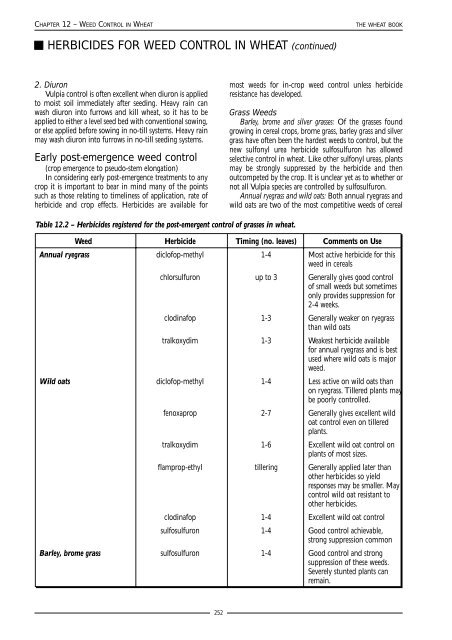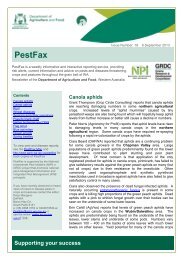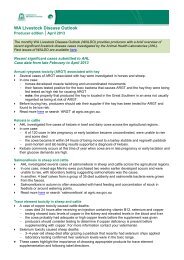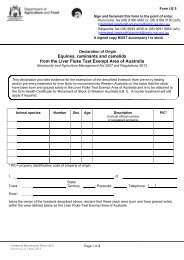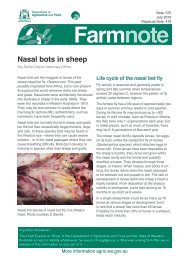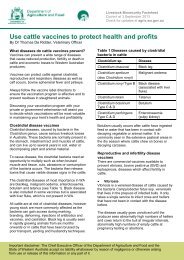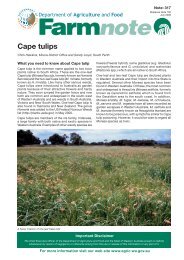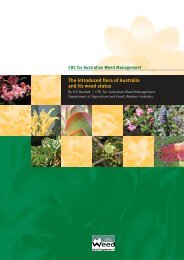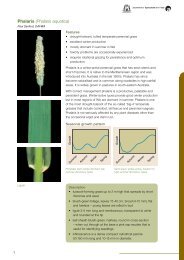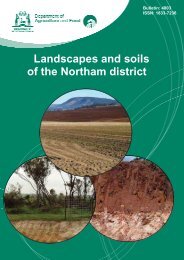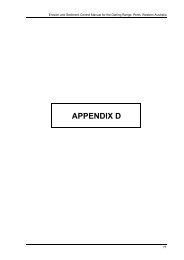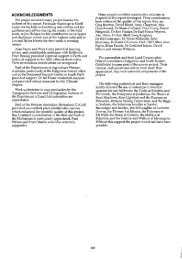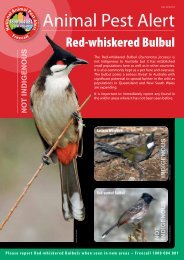The wheat book : principles and practice - Department of Agriculture ...
The wheat book : principles and practice - Department of Agriculture ...
The wheat book : principles and practice - Department of Agriculture ...
You also want an ePaper? Increase the reach of your titles
YUMPU automatically turns print PDFs into web optimized ePapers that Google loves.
CHAPTER 12 – WEED CONTROL IN WHEAT THE WHEAT BOOK<br />
HERBICIDES FOR WEED CONTROL IN WHEAT (continued)<br />
2. Diuron<br />
Vulpia control is <strong>of</strong>ten excellent when diuron is applied<br />
to moist soil immediately after seeding. Heavy rain can<br />
wash diuron into furrows <strong>and</strong> kill <strong>wheat</strong>, so it has to be<br />
applied to either a level seed bed with conventional sowing,<br />
or else applied before sowing in no-till systems. Heavy rain<br />
may wash diuron into furrows in no-till seeding systems.<br />
Early post-emergence weed control<br />
(crop emergence to pseudo-stem elongation)<br />
In considering early post-emergence treatments to any<br />
crop it is important to bear in mind many <strong>of</strong> the points<br />
such as those relating to timeliness <strong>of</strong> application, rate <strong>of</strong><br />
herbicide <strong>and</strong> crop effects. Herbicides are available for<br />
Table 12.2 – Herbicides registered for the post-emergent control <strong>of</strong> grasses in <strong>wheat</strong>.<br />
252<br />
most weeds for in-crop weed control unless herbicide<br />
resistance has developed.<br />
Grass Weeds<br />
Barley, brome <strong>and</strong> silver grasses: Of the grasses found<br />
growing in cereal crops, brome grass, barley grass <strong>and</strong> silver<br />
grass have <strong>of</strong>ten been the hardest weeds to control, but the<br />
new sulfonyl urea herbicide sulfosulfuron has allowed<br />
selective control in <strong>wheat</strong>. Like other sulfonyl ureas, plants<br />
may be strongly suppressed by the herbicide <strong>and</strong> then<br />
outcompeted by the crop. It is unclear yet as to whether or<br />
not all Vulpia species are controlled by sulfosulfuron.<br />
Annual ryegrass <strong>and</strong> wild oats: Both annual ryegrass <strong>and</strong><br />
wild oats are two <strong>of</strong> the most competitive weeds <strong>of</strong> cereal<br />
Weed Herbicide Timing (no. leaves) Comments on Use<br />
Annual ryegrass dicl<strong>of</strong>op-methyl 1-4 Most active herbicide for this<br />
weed in cereals<br />
chlorsulfuron up to 3 Generally gives good control<br />
<strong>of</strong> small weeds but sometimes<br />
only provides suppression for<br />
2-4 weeks.<br />
clodinafop 1-3 Generally weaker on ryegrass<br />
than wild oats<br />
tralkoxydim 1-3 Weakest herbicide available<br />
for annual ryegrass <strong>and</strong> is best<br />
used where wild oats is major<br />
weed.<br />
Wild oats dicl<strong>of</strong>op-methyl 1-4 Less active on wild oats than<br />
on ryegrass. Tillered plants may<br />
be poorly controlled.<br />
fenoxaprop 2-7 Generally gives excellent wild<br />
oat control even on tillered<br />
plants.<br />
tralkoxydim 1-6 Excellent wild oat control on<br />
plants <strong>of</strong> most sizes.<br />
flamprop-ethyl tillering Generally applied later than<br />
other herbicides so yield<br />
responses may be smaller. May<br />
control wild oat resistant to<br />
other herbicides.<br />
clodinafop 1-4 Excellent wild oat control<br />
sulfosulfuron 1-4 Good control achievable,<br />
strong suppression common<br />
Barley, brome grass sulfosulfuron 1-4 Good control <strong>and</strong> strong<br />
suppression <strong>of</strong> these weeds.<br />
Severely stunted plants can<br />
remain.


